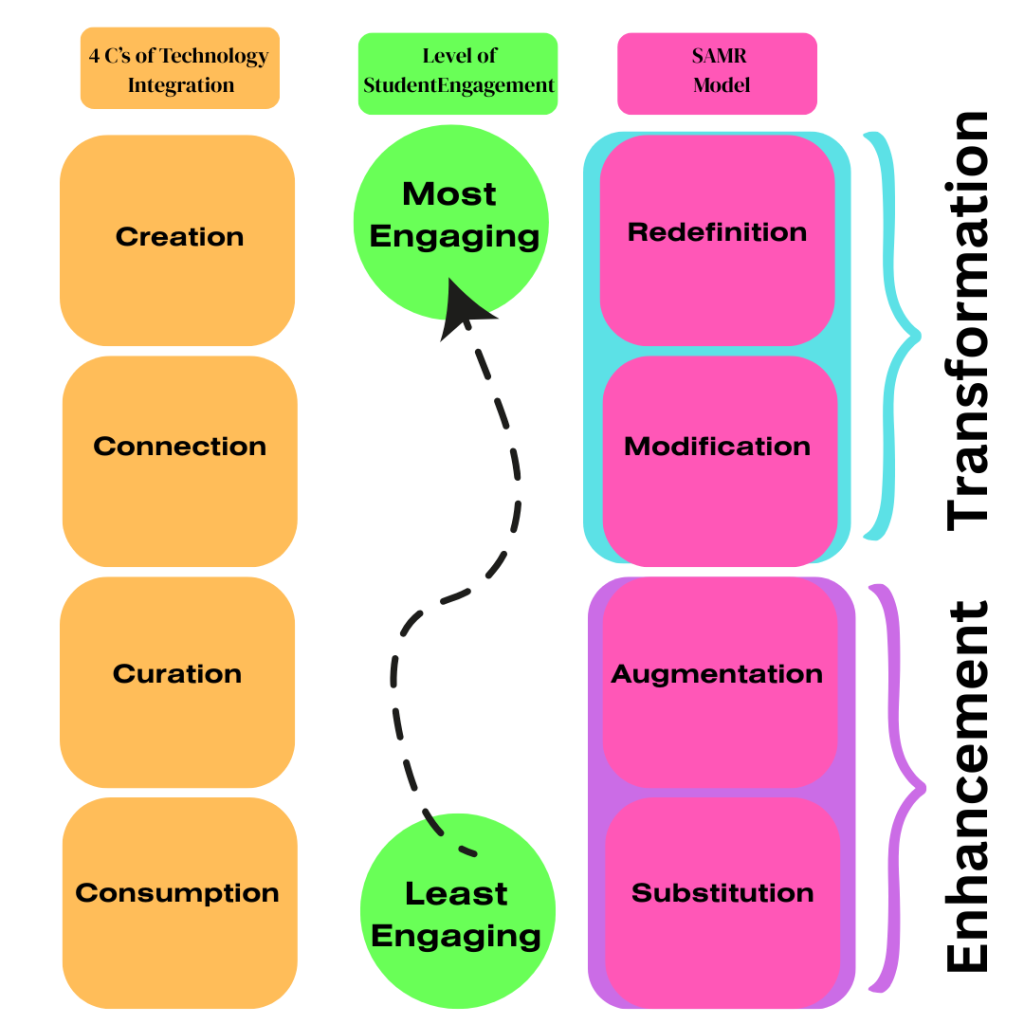Using the SAMR Model of Tech Integration in the Classroom
An edtech expert describes what substitution, augmentation, modification, and redefinition mean in lesson design—and how to reach that elusive final level.
Your content has been saved!
Go to My Saved Content.The SAMR framework of technology integration—substitution, augmentation, modification, redefinition—has been around since 2010. Other models have been developed in that time, but I find the SAMR model easiest to understand for future educators.
Some describe SAMR as the slope from the shallow to the deep end of the pool, while others refer to it as a ladder. Regardless of how it is explained, getting to the level of redefinition sometimes feels elusive, partially because there aren’t truly clear-cut lines and concrete definitions of the SAMR levels; while it’s fairly easy to understand that S is substitution, moving farther along the spectrum of technology integration can get a bit confusing.
After I teach my university preservice students about the SAMR model, we often use it to analyze lesson plans they created. “You’re having your students type a paper in social studies? That’s substitution.” “Your social studies students are typing the paper in a Google Doc, and you are leaving feedback in the comments? That’s augmentation.” Students and teachers often get stuck in these two levels, which are best defined as enhancements to learning, but how does a social studies lesson move toward modification?
In the classroom
Perhaps students could create a video or podcast to share their learning. This simple shift would empower students with the possibility of a more global audience and a desire to show the world what they know, and it would move the lesson to the modification level.
My favorite example of redefinition in a social studies class happened when my friend from the Philippines stayed up until 2 a.m. to answer questions that our sixth-grade students had about her country. Our video guest’s father played a crucial role in the Philippine military during the 1989 coup attempt in that country. The students asked real-life questions about Philippine culture and were amazed to hear the stories she shared. Engagement was extremely high during that class period.
But let’s be honest, not every lesson lends itself to the redefinition level of the SAMR model, and that’s OK. There is no wrong level of technology integration. There are benefits to every level, but after 20 years in the educational technology world, I have noticed that the higher they go up the SAMR model, the more on-task students seem to be.

So the question to ask yourself that bears answering is, “How often am I striving for transformational use of technology in the classroom? As engagement often equals increased learning, how can I move toward the redefinition level?”
Truthfully, we teachers are usually stifled by time constraints, good technology, and our own creativity when striving for transformational technology integration. I often get asked, “What does the redefinition level of the SAMR model look like in a math classroom?” Instead of students looking at 3D models of geometric shapes on a piece of paper to calculate volume and surface area, imagine if they used virtual reality software to design and build their own 3D models. This immersive experience would go beyond static diagrams and even physical models. Students would need to engage with spatial reasoning. Now imagine them sharing their designs with fellow students for critique purposes based on a rubric. Voilà! Redefinition.
What about science? I once worked with a fifth-grade teacher who felt very strongly about being good stewards of Earth. Her students created websites, using Google Sites, on a topic of their choosing regarding pollution and its impact. When students use technology to create artifacts of learning and there is a possibility for a more global audience, the lessons are moving toward redefinition. Presenting work to a global audience often increases student effort due to the heightened awareness of increased exposure.
As you consider how you are currently integrating technology for student use, remember that the more interactive a student is with technology, the more engaging it will be. When students primarily use technology to consume content or gather research, instruction typically operates at the substitution or augmentation levels of the SAMR model. Students using technology for creation and connection purposes are likely approaching the redefinition level.
However, tools alone do not lead to transformational teaching and learning. How the tools are integrated into a lesson by your students matters. For instance, typing a paper in a Google Doc is a substitution for paper and pencil, but typing a paper into a Google Doc and then having it published to the web to be shared with a student in another country for collaborative work has the possibility of reaching the redefinition level.
As mentioned earlier, time can be the most challenging variable in reaching redefinition. As someone who was once an elementary STEM coordinator, I know that project-based learning and design thinking lessons take a lot of time. Creating meaningful technology integration lessons can fall into the same category.
Whether it is having students create a story using a platform like Delightex (formerly CoSpaces Edu) or asking them to collect data on local environmental factors using mobile apps and sensors, tech-infused lessons are rarely a one-and-done use of class time. While this might seem too much trouble, some of my all-time favorite lessons happened at the redefinition level. Why? When technology aids students in taking ownership of their learning, it becomes an “Aha!” moment for both me and my students.
